|

by Ernie C. Salgado, Jr., MBA,Soboba Band of Luiseño Indians
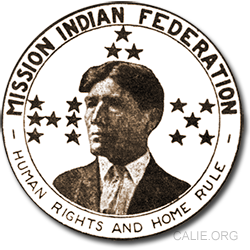 This is a proposal to develop an historical documentary of the Southern California American Indian people, of our Struggle, Adaptation and Survival. Our people, the Native American Aboriginal People that have lived in what is known today as Southern California for over 50,000 years, which is supported by the archeological discoveries such as what is referred to as the “La Jolla Man” near the City of San Diego, California, and more so by our traditional oral history and legends. This is a proposal to develop an historical documentary of the Southern California American Indian people, of our Struggle, Adaptation and Survival. Our people, the Native American Aboriginal People that have lived in what is known today as Southern California for over 50,000 years, which is supported by the archeological discoveries such as what is referred to as the “La Jolla Man” near the City of San Diego, California, and more so by our traditional oral history and legends.
This is the current accounting of the past one hundred years, the legend of our fight for survival, to maintain our culture, traditions and the political structure we created to preserve our way of life. It is about how it has survived to influence the current political policies of our tribal governance as well as the decision making process within our tribal Governments, the State of California and at the highest level of the nation within the halls of the United States Congress as well as the Administrative branch.
To better understand the relationship between the California American Indian tribes and the United States Government one must be aware of two important facts; first, the California Indian tribes do not have any treaties with the Federal Government, and secondly, the relationship between the California tribes and the United State Government is political and not racial. However, the Federal Government through the Bureau of Indian Affairs has made every effort to make the relationship racial, and to some extent they have been successful, as will be demonstrated later. It has also extended Treaty Rights made with Mid-western and eastern tribes to the California Indian in its effort to create a “One Size Fits All” policy for dealing with the Tribal Governments.
This historical documentary is an assembly of myths, historical realities and it is prepared with deep respect to the plight and exploits of the Native American people who have lived in the southern region of California for over 500 centuries in what is currently known as Riverside, San Bernardino, San Diego counties and as far north as Santa Barbara County.
Regardless of the numerous academia theories of how the Southern California American Indian came to inhabit the area, the indisputable truth is that the California Indian people were here long before any European contact.
Historical myths have Christopher Columbus discovering America in 1492 A.D. Later in 1579 Sir Francis Drake was reported to have landed at what has become known as “Drakes Bay” and is said to have established communication with the native inhabitants and took possession of the country in the name of England, calling it “New Albion”. Drakes Bay is a small bay on the coast on northern California approximately 30 miles northwest of the City of San Francisco. Yet, Chinese record indicates that in 458 A.D. explorer, Hui Shan, who is said to have been a mendicant Gondaran monk, sailed the Pacific as he noted in his log “…seeing tall trees with redwood along the coast…” J. R. Cabrillo a Portuguese navigator is credited by historian as discovering the territory of what is currently known as the State of California in 1542. Still another early Spaniard explorer, Viscayno, is reported to have visited the new lands in 1602.
To our people this is all irrelevant as to what followed the invasion and our survival was and is our only concern.
At first no attempt was made at colonization until the Spanish Order of the Catholic Franciscan Fathers established the first of 21 missions in San Diego, California, in 1769. Over the next 50 years from 1779 to around 1818-1821 the Franciscan Fathers assembled over 20,000 of our people from the surrounding areas as to what is currently identified as San Diego, Riverside, San Bernardino and Santa Barbara Counties to build and maintain the Catholic mission structure, but over the years many of the Indian people rejected the dominance of the church and abandoned the missions resulting in the decline of the power of Franciscan Fathers and the missions.
However, the Franciscan Fathers did not give up with out using every effort to maintain control. Beatings, imprisonment, starvation, and holding children as hostages were some of the tactics used which only prolonged the exodus. This was well documented in Rupert and Jennette Henry Costo’s book The Missions of California; A Legacy of Genocide. San Francisco: Indian Historian Press, 1987. The book was banned when it was first published.
The loss of control became more acute after the Mexican government had succeeded in gaining its formal independence from Spain in 1821, and finally with the United States Government in 1848 after it successfully defeated Mexico.
In addition to the slavery of our people by the Catholic Church, the white settlers and Mexican ranchers also maintained “Indian Slaves”. Women and children were the primary targets for kidnapping and sold into slavery or indenturment as it was referred to at the time.
Under the leadership of James Knox Polk, the 11th President of the United States of American (1845–1849) who provoked Mexico into war under the veil of Manifest Destiny to claim the west and expand the national boundaries from the Atlantic Ocean to the Pacific Ocean and from Canada to the newly established southern border of Mexico in Southern California, Texas and Arizona.
On February 2, 1848, The United States Government signed the Treaty of Guadalupe Hidalgo with Mexico ending the Mexican-American War making California a territory of the United States of American. However, the United States Congress never ratified the Treaty of Guadalupe Hidalgo leaving the Indian people without any protections even though they were referred to as “Savages” in the Treaty.
When California became the 31st State on September 9, 1850, it did little to improve the status of the Native American tribal people in California and many lost or were never recognized by the federal government. In way of example of the disregard for the rights first inhabitants during the gold rush, a five-dollar bounty was placed on the Indians to prevent them from interfering with the search for gold on their lands. However, this was more rampant in the central part of the State.
Although the United States Government referred to the Native people geographically located in the influential sphere of the missions as “Mission Indians” they were in fact individual and separate tribal groups. Within the different Indian tribal groups there were several different languages and the tribal groups were also divided into many different independent clans containing as many as five hundred to twelve hundred people in each clan. These clans controlled separate territories of several hundred square miles each and maintained their own political authority. Each clan was allied through ritual systems that provided political stability and networks for economic exchange. Although the clans had many similarities they maintained their autonomy and self-rule.
Tribal beliefs were clearly stated in various song series and historical accounts that described a clan's sacred and secular history as well as providing guidelines for social behavior. These beliefs were reinforced on a regular basis and annually in clan ritual centers where the texts of the song progressions were presented in their entirety a process requiring several days to complete. The most important element of these gatherings was the ceremonies, which honored those members of a clan who had died since the last ritual had been performed. Still other annual ceremonies later became known as “Fiestas” which were normally held during the summer months to celebrate, share crops and livestock. Today many tribal leaders have adopted the Pow Wow of the Midwestern Natives in place of the traditional Fiestas.
For Indian people, their traditional spiritual values and concepts of how their God created the world. Although the creation stories are diverse among the various tribal group the essentially tells of the origin of the world and the consequences of that death for humans, which included the need for death, social values, and traditions. It also describes the basic concepts of supernatural power and its proper use in the current world.
Remarkably, the arrival of the Spanish and the Americans did not obliterate the Native peoples own political, legal, and religious systems. The most damaging effects the Europeans had on the Indians was in the confiscation of their land, the death of an unimaginably 80 percent of the Indian people from exposure to European diseases, and the continuing loss of political autonomy.
Initially, some of the Indian people were not affected by the Spanish mission system, as were the other tribal groups in the region. On the other hand, they were very much affected by the economic systems imposed on their homelands. They engaged in wage labor for the Spanish and Mexicans and became an integral part of the labor force in Southern California.
The Southern California Indian people were very active in political protests for many years. From 1840 to 1891 they united into quasi-military groups under the leadership of last Tribal War Chiefs, such as Juan Antonio and Antonio Garza, not only to defend themselves from the encroachments of Spaniards, Mexicans, and Americans rule, but the Catholic Church’s Mission system as well.
When California became the 31st State on September 9, 1850, the Indian people were totally disregarded by the State and to some extend by the United States Government. From 1950 to 1880 the Southern California Indian people joined together in families and clans, which were identified as tribes by the federal Government. In some cases two or more clans were jointed together to form a tribal group. However, the Indian people to this day have maintained their individual family and clan identities.
After the United States Government established the reservations system nationally and in California in the early 1880’s the tribal political confederations disappeared. However, within a couple of decades the Indian leaders had formed other political organizations, the most prominent was the Mission Indian Federation. This organization arose in response to oppressive practices of the Government Bureau of Indian Affairs and they became a significant conduit for political opposition against the federal government's policies regarding the management Indian affairs by the Bureau of Indian Affairs.
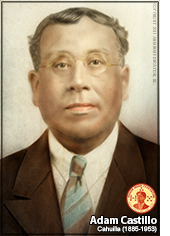 From the early 1900’s the Mission Indian Federation, under the leadership of Adam Castillo, until his death in 1953, was the compelling influence in the redressing of economic, political, and legal grievances of the American Indian people. Mr. Castillo also served as the Tribal Chairman for the Soboba Band of Mission Indians. (In 2003 the tribe changed its name to the Soboba Band of Luiseño Indians, as did many other tribes, dropping the word “Mission”). From the early 1900’s the Mission Indian Federation, under the leadership of Adam Castillo, until his death in 1953, was the compelling influence in the redressing of economic, political, and legal grievances of the American Indian people. Mr. Castillo also served as the Tribal Chairman for the Soboba Band of Mission Indians. (In 2003 the tribe changed its name to the Soboba Band of Luiseño Indians, as did many other tribes, dropping the word “Mission”).
The Mission Indian Federation under the leadership of Mr. Castillo successfully challenged the United States Government and won some very major political victories. The first was the dismissal of charges against 57 members of the Mission Indian Federation for “Conspiracy against the U.S. Government” by the U.S. District Courts in Los Angeles, California in 1923. The Government’s contention was that the 57 members of the Mission Indian Federation were promoting “Bolshevistic Doctrines”.
Nothing could have been farther from the truth as the Federation Constitution Article II, Section 1. clearly states “Human Rights and Home Rule” shall be the slogan of the Mission Indian Federation”. Currently tribal leaders understand “Home Rule” to be Tribal Sovereignty. The second victory was gaining American citizenship in 1924, fifty-six years after the 14th Amendment to the Constitution was ratified on July 9, 1868, which granted citizens to all persons born or naturalized in the United States except the American Indian.
After the arrest and exoneration of the 57 members of the Federation the group became more selective in their discussions and meeting. The BIA continued to undermine their efforts and gave their support to tribal members that opposed the Federation. Regardless of all the efforts of the BIA to destabilize and demonize them, the BIA was forced to recognize them as a political force. In some report the Federation is described as the tribal “Shadow Government” of the tribes.
After the death of Adam Castillo in 1853 the Federation continued under the leadership of Mr. Pico from the Pechanga Indian reservation. However, for many reasons the movement became less organized and was resurrected in the late 60’s and early 70’s.
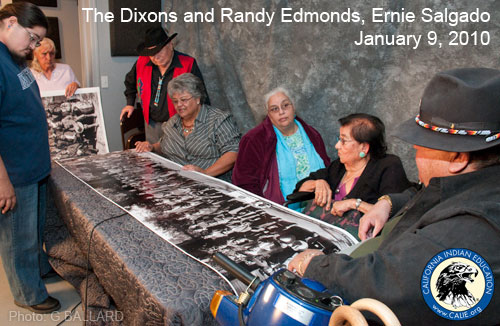
January 9, 2010: Randy Edmonds and the Dixon women (Pauma tribe) look at Ernie's 12-foot restoration of a historical 1920 Mission Indian Federation photograph during filming of "The Struggle, Adaptation and Survival of the Aboriginal People in California".
One of the most significant single acts of American Indian activism was the occupation of Alcatraz from Nov. 20, 1969, until June 11, 1971, reclaiming it as Indian land and demanding fairness and respect for Indian peoples, the Mission Indian Federation? The occupation of Alcatraz was the one of the most significant demonstrations of the past century. That action in it self brought the attention of the nation and the world on not only California Indians but for all American Indians.
Although the California tribes have made great advancements over the past 50 years they are still not a free people. The BIA still continues to rule many actions of the tribal governments by policy, regulations and oversight. Although there are many descendents of the Mission Indian Federation active in tribal politics the mindset of many tribal members continues to be Government dependency through the BIA.
For the past century democratically elected Tribal Councils have provided the leadership for the southern California Indian tribes. Issues of health, education, and welfare were matters of concern for the Bureau of Indian Affairs, Indian Health Service and State of California, since the partially jurisdiction of the law enforcement was transferred to the State in the 1953 under the authority of Public Law 280 resulting in conflict between the California Indian Tribes and the State, which was finally partially settled by United States Supreme Court is 1976 declaring American Indian Tribal Government as Sovereign Nations, over two hundred years after the signing the Declaration of Independence. However, Indian lands continue to be held in trust by the U.S. Government on behalf of the Indian tribes which in itself is another bureaucratic disaster that continues to this day with no plan for resolution.
Another significant piece of legislation is Public Law 93-638, the “Indian Self-Determination and Education Assistance Act” that was signed in 1975 by President Richard M. Nixon. This act allowed the individual tribes to provide and manage their own resources as well as to contracting and manage service that were providing social and educational benefits for their people. The impact of this legislation has allowed the Native American people to unlock the chains of poverty and to gain a powerful foothold in the American political arena. The legislation was first implemented in 1976 two hundred years after the signing the Declaration of Independence. However, Indian lands continue to be held in trust by the U.S. Government on behalf of the Indian tribes. Clearing the way for Indian Gaming starting with high stakes bingo and proliferating into full-fledged gambling casinos.
Although the word “Self” is included in the title it only makes reference to the tribal Governments and not the individual which is the basis for capitalism and this is genesis for the friction between the Federation and Government. The government policy was and still is for the Native American to “become more simulated” to the American way of life however, they were prevented from exercising their individual rights and the BIA maintained that the entire tribe must benefit. Sounds a lot like “Redistribution of the Wealth” rhetoric we hear more of from our political leaders today.
Although the formal policy of the Government continues to be to bring the Native American into the mainstream of American society and the termination of the tribal structure yet the unwritten policies of the Bureau of Indian Affairs and all the politicians in control of the central government is to maintain “Tribalism” as a “Socialist” or “Progressive” formation of government within the tribal political structure. The Mission Indian Federation opposed these policies while supporting the rights of the tribe as a whole and the individual rights of tribal members as well. The conflict between the U.S. Government through the Bureau of Indian Affairs and the Mission Indian Federation was the “Socialist” or “Progressive” formation of government supported by the Bureau of Indian Affairs. “Home Rule”, Individual Rights” and “Personal Responsibility” was strongly supported by the Mission Indian Federation. Officially the Federal Government has been successful in keeping the “Socialist” or “Progressive” formation of government in place within the majority of the Tribal Governments to this day.
With the current financial windfall from Indian gaming for a few of the Nations Tribal Governments, many problems the gaming tribes were forced to deal with because of the lack of financial resources have now been or to some extent become less burdensome. However, other problems that have resulted from the proliferation of Indian Gaming such as mismanagement, lack of management skills, and the misappropriation of funds by employees and tribal leaders have yet to be dealt with by the tribal leadership and the responsibly authorities.
Helen Hunt Jackson wrote about the racism, exploitation and cruelty of the Native people in the Century of Dishonor and Ramona. However, “Forgotten Warriors” Mission Indian Federation is a different story it is about the mysterious covert tribal underground “The Tribal Brotherhood” that resurfaced in the late 50’s and early 60’s reviving the vision to living under “Home Rule”, Individual Rights” and “Personal Responsibility” that was advocated by the early political movement of the Mission Indian Federation and was later adopted by the occupation of Alcatraz and the American Indian Movement (AIM) on a national and world level.
The intent of the “Forgotten Warriors” The Mission Indian Federation is to present a unique contemporary glimpse of Tribal Sovereignty and to identify the current Tribal leaders that are descendents of the Mission Indian Federation members and their continued efforts to promote the tribal customs and traditions of their forefathers and mothers to bring about the independents of our people through “Less Government”, “Home Rule”, Individual Rights” and “Personal Responsibility”.
I would like obtain financial support to produce a mini 30- to 45-minute video documentary of the “Forgotten Warriors” The Mission Indian Federation as an educational instrument for our youth, our current tribal leaders and non-tribal communities.
In preparation for this project I have conducted an extensive research investigation of the federal archives on file at the Riverside location at 23123 Cajalco Road, Perris, CA 92570-7298, the Riverside Library and the Smiley Library at the University of Redlands. I have also interviewed several Tribal Leaders on video. I may be contacted directly by E-mail HERE or by telephone at 951.217.7205 — looking forward to hearing from you.
|
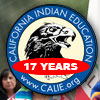
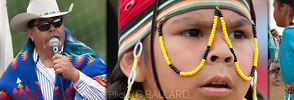


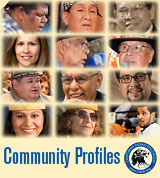
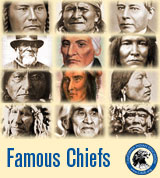
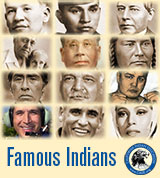


 This is a proposal to develop an historical documentary of the Southern California American Indian people, of our Struggle, Adaptation and Survival. Our people, the Native American Aboriginal People that have lived in what is known today as Southern California for over 50,000 years, which is supported by the archeological discoveries such as what is referred to as the
This is a proposal to develop an historical documentary of the Southern California American Indian people, of our Struggle, Adaptation and Survival. Our people, the Native American Aboriginal People that have lived in what is known today as Southern California for over 50,000 years, which is supported by the archeological discoveries such as what is referred to as the  From the early 1900’s the Mission Indian Federation, under the leadership of
From the early 1900’s the Mission Indian Federation, under the leadership of 
